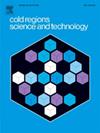A predictive model for ice lens width considering freezing rate in artificial ground freezing for tunnel construction
IF 3.8
2区 工程技术
Q1 ENGINEERING, CIVIL
引用次数: 0
Abstract
In artificial ground freezing (AGF) for tunnel construction, adjusting the freezing patterns can significantly mitigate frost heave and thawing settlements. However, current research on open freezing has not thoroughly explored how different freezing patterns affect frost. This gap in knowledge makes it difficult to provide clear guidance for adjusting freezing patterns in AGF engineering. To address this issue, this paper proposes a predictive model for ice lens width, which can serve as a valuable reference for real-time adjustments of freezing patterns. The model is based on experimental investigations into the freezing rate at the cold side of open freezing under different patterns. Experiment results reveal a correlation between the movement velocity of the freezing front and the ice lens width: a higher velocity results in a narrower ice lens. Based on the second theory of frost heave, a theoretical model for predicting ice lens width under varying freezing rates has been developed, explaining the observed correlation. However, this theoretical model involves many parameters that are difficult to obtain in practical engineering. For the convenience of engineering applications, a simplified model based on the theoretical model was proposed. Validation of this simplified model shows that it has good predictive performance. When combined with a custom temperature sensor, this simplified model offers a solution for real-time monitoring and continuous prediction of tunnel frost heave deformation in AGF engineering.
隧道人工冻结中考虑冻结速率的冰透镜宽度预测模型
在隧道人工冻结施工中,调整冻结方式可以显著缓解冻胀和融化沉降。然而,目前对开放冻结的研究尚未深入探讨不同冻结方式对结霜的影响。这种知识上的差距使得难以为AGF工程中冻结模式的调整提供明确的指导。针对这一问题,本文提出了冰透镜宽度的预测模型,为冰冻模式的实时调整提供了有价值的参考。该模型是基于不同模式下开放冻结冷侧冻结速率的实验研究。实验结果表明,冻结锋的运动速度与冰透镜宽度之间存在相关性:速度越快,冰透镜宽度越窄。基于第二种冻胀理论,建立了在不同冻结速率下预测冰透镜宽度的理论模型,解释了观测到的相关性。然而,该理论模型涉及许多难以在实际工程中获得的参数。为了便于工程应用,在理论模型的基础上提出了一种简化模型。经验证,该简化模型具有良好的预测性能。该简化模型与自定义温度传感器相结合,为AGF工程中隧道冻胀变形的实时监测和连续预测提供了解决方案。
本文章由计算机程序翻译,如有差异,请以英文原文为准。
求助全文
约1分钟内获得全文
求助全文
来源期刊

Cold Regions Science and Technology
工程技术-地球科学综合
CiteScore
7.40
自引率
12.20%
发文量
209
审稿时长
4.9 months
期刊介绍:
Cold Regions Science and Technology is an international journal dealing with the science and technical problems of cold environments in both the polar regions and more temperate locations. It includes fundamental aspects of cryospheric sciences which have applications for cold regions problems as well as engineering topics which relate to the cryosphere.
Emphasis is given to applied science with broad coverage of the physical and mechanical aspects of ice (including glaciers and sea ice), snow and snow avalanches, ice-water systems, ice-bonded soils and permafrost.
Relevant aspects of Earth science, materials science, offshore and river ice engineering are also of primary interest. These include icing of ships and structures as well as trafficability in cold environments. Technological advances for cold regions in research, development, and engineering practice are relevant to the journal. Theoretical papers must include a detailed discussion of the potential application of the theory to address cold regions problems. The journal serves a wide range of specialists, providing a medium for interdisciplinary communication and a convenient source of reference.
 求助内容:
求助内容: 应助结果提醒方式:
应助结果提醒方式:


